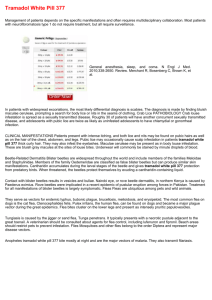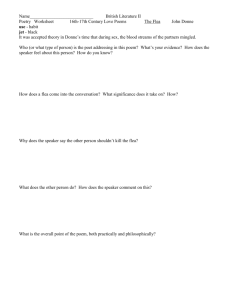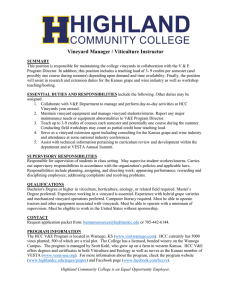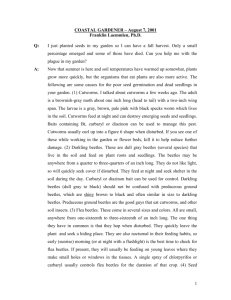Timely Viticulture
advertisement
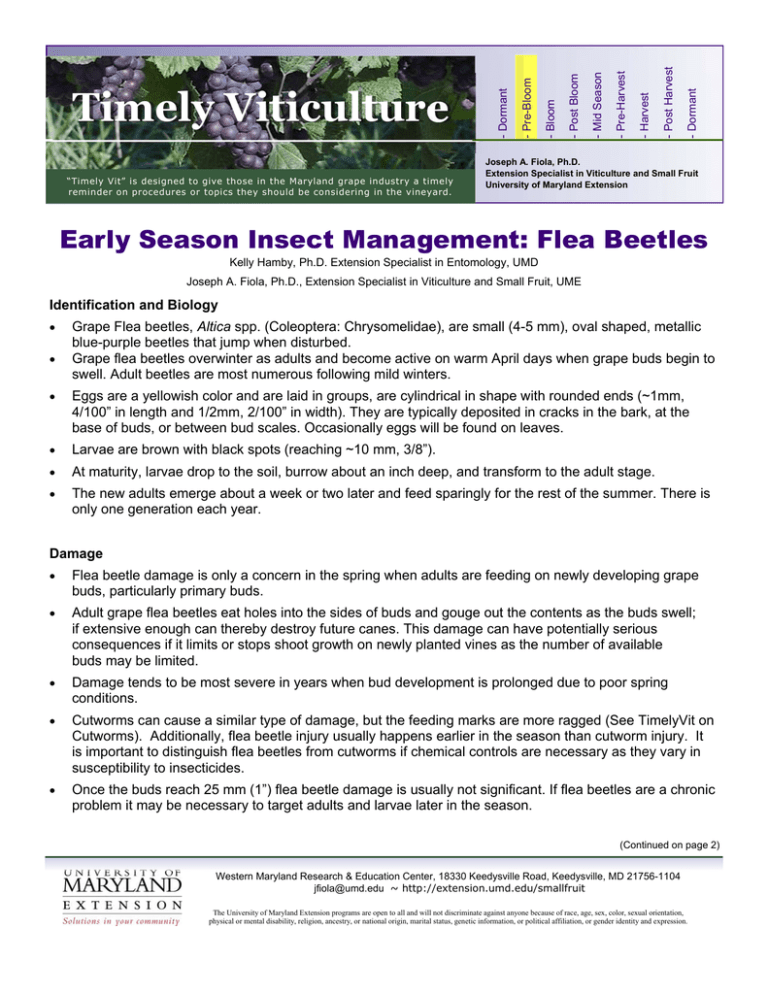
“Timely Vit” is designed to give those in the Maryland grape industry a timely reminder on procedures or topics they should be considering in the vineyard. - Dormant - Post Harvest - Harvest - Pre-Harvest - Mid Season - Post Bloom - Bloom - Pre-Bloom - Dormant Timely Viticulture Joseph A. Fiola, Ph.D. Extension Specialist in Viticulture and Small Fruit University of Maryland Extension Early Season Insect Management: Flea Beetles Kelly Hamby, Ph.D. Extension Specialist in Entomology, UMD Joseph A. Fiola, Ph.D., Extension Specialist in Viticulture and Small Fruit, UME Identification and Biology Grape Flea beetles, Altica spp. (Coleoptera: Chrysomelidae), are small (4-5 mm), oval shaped, metallic blue-purple beetles that jump when disturbed. Grape flea beetles overwinter as adults and become active on warm April days when grape buds begin to swell. Adult beetles are most numerous following mild winters. Eggs are a yellowish color and are laid in groups, are cylindrical in shape with rounded ends (~1mm, 4/100” in length and 1/2mm, 2/100” in width). They are typically deposited in cracks in the bark, at the base of buds, or between bud scales. Occasionally eggs will be found on leaves. Larvae are brown with black spots (reaching ~10 mm, 3/8”). At maturity, larvae drop to the soil, burrow about an inch deep, and transform to the adult stage. The new adults emerge about a week or two later and feed sparingly for the rest of the summer. There is only one generation each year. Damage Flea beetle damage is only a concern in the spring when adults are feeding on newly developing grape buds, particularly primary buds. Adult grape flea beetles eat holes into the sides of buds and gouge out the contents as the buds swell; if extensive enough can thereby destroy future canes. This damage can have potentially serious consequences if it limits or stops shoot growth on newly planted vines as the number of available buds may be limited. Damage tends to be most severe in years when bud development is prolonged due to poor spring conditions. Cutworms can cause a similar type of damage, but the feeding marks are more ragged (See TimelyVit on Cutworms). Additionally, flea beetle injury usually happens earlier in the season than cutworm injury. It is important to distinguish flea beetles from cutworms if chemical controls are necessary as they vary in susceptibility to insecticides. Once the buds reach 25 mm (1”) flea beetle damage is usually not significant. If flea beetles are a chronic problem it may be necessary to target adults and larvae later in the season. (Continued on page 2) Western Maryland Research & Education Center, 18330 Keedysville Road, Keedysville, MD 21756-1104 jfiola@umd.edu ~ http://extension.umd.edu/smallfruit The University of Maryland Extension programs are open to all and will not discriminate against anyone because of race, age, sex, color, sexual orientation, physical or mental disability, religion, ancestry, or national origin, marital status, genetic information, or political affiliation, or gender identity and expression. Timely Viticulture Early Season Insect Management: Flea Beetles continued from page 1 Pre-Bloom Monitoring and Thresholds Grape flea beetle bud damage is usually found in vineyard borders near woody areas, where monitoring should be prioritized. Scouting along the vineyard perimeter on all sides, as well as the interior, for adult beetles and bud damage is recommended until buds are about 25mm, 1” in size. Bud inspection for adults is a must at least until there is one inch of new growth; then scout for the larvae. A small amount of damage is tolerable with the vigor capacity of most vineyards in the East, and treatments are not warranted until bud damage exceeds 4%. Management Most vineyards do not typically require sprays of this pest if attention was paid to winter vineyard clean up and destruction of local habitats. Within vineyards, flea beetles will overwinter in surface debris as adults, so removing local habitats and fall/winter vineyard clean up (removal of leaf litter and debris in and around the vines) should prevent damaging spring populations. Outside the vineyard, cleaning up woodlots and wasteland areas near the vineyard will also help. Most vineyards do not typically require sprays of this pest if these cultural tactics are performed. For more detail information please visit: - http://www.virginiafruit.ento.vt.edu/GFB.html - http://www.nysipm.cornell.edu/factsheets/grapes/pests/gfb/gfb.asp - http://grapes.msu.edu/fleabeetle.htm 050615 Western Maryland Research & Education Center, 18330 Keedysville Road, Keedysville, MD 21756-1104 jfiola@umd.edu ~ http://extension.umd.edu/smallfruit The University of Maryland Extension programs are open to all and will not discriminate against anyone because of race, age, sex, color, sexual orientation, physical or mental disability, religion, ancestry, or national origin, marital status, genetic information, or political affiliation, or gender identity and expression.
